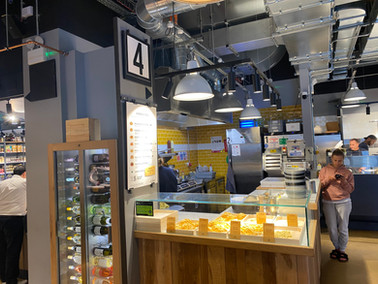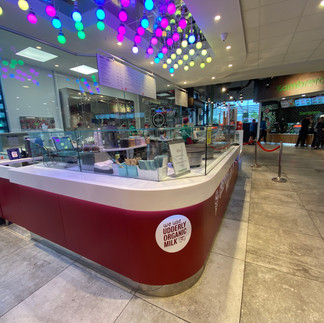Food halls: key trends and opportunities
- Gavin Rothwell
- Oct 19, 2022
- 4 min read
Food halls may have faced more challenges than many other outlets during covid, but they are reemerging with renewed vigour and expansion goals. Here we highlight some of the key trends we’ve been seeing in this space.
1. The food hall as a residential hub. We’re seeing more development of food hall concepts as part of residential developments - typically urban apartment blocks. MMyWoodWharf in London’s Canary Wharf, complete with underground jazz bar, is one example. Gotham West, with an integrated cocktail bar, on New York’s 11th Avenue, is another. There's certainly relevance here for a wider range of concepts, including convenience stores that meet a sufficient breadth of consumer needs. We’d expect more landlords to be open to new concepts which meet multiple food / drink retail and foodservice missions in urban locations.
2. Food halls becoming stronger events destinations. The best recent example we’ve seen here is Time Out Market Chicago, where our most recent visit coincided with the build-up to its Oktoberfest celebration, in conjunction with Sam Adams. But the event focus is far broader than this – elevated screens show sport, helping drive more reasons for visits more often, while it’s also added a dedicated restaurant space – chef Stephen Gillander has just opened his Valhalla concept there, elevating the appeal of the food proposition into fine as well as casual dining. There’s also a demonstration kitchen, and a broader events programme designed with elements that appeal to both adults and children, helping to reinforce its positioning as a family destination.
3. The rotating food offer. The principle here is around always offering customers something new and different on their visits through having a regularly rotating roster of food operators in the food hall. A great example of this is in Sale Food Hall, a small neighbourhood, food hall concept, run by Mital Morar’s Store Retail Group, in Greater Manchester, comprising of four different kitchen counters, with the vendors rotating on a regular basis. It's not easy, it needs considerable management focus and great relationships with a wide range of street food vendors to work effectively, but we see this as a concept that holds considerable potential across a wide range of locations.
4. The transit location food hall. Perhaps not your first thought around the future opportunity for food halls, but we see considerable scope here. We’ve seen several initiatives already in this space – the Great Northern Food Hall at New York’s Grand Central Station is well established, but its success is probably as much about its central Manhattan location as it is about its transit relevance. Meanwhile from a roadside perspective, J14 Mayfield in Co. Kildare, Ireland, might be easier to categorise as an extended roadside services, but in its combination of global and local food-to-go operations, across a variety of cuisines, shows some great pointers towards what roadside food halls could emerge as in the future. From an airport perspective, there’s tremendous scope here, and some significant activity in place, though there’s considerably further for this to go now and in the future to help deliver an upgraded on-the-move dining experience for travellers.
5. The destination food hall. London is now lucky enough to have several of these – Borough Market has for many defined this concept, while Mercato Metropolitano and Seven Dials are also excellent examples. Elsewhere, the likes of Torvehallerne in Copenhagen, Markhal in Rotterdam and Foodhallen in Amsterdam all impress. What we see from these food halls is a draw extending beyond the food hall itself, as more food and drink led operators seek to locate close to the food halls themselves, helping to create a bigger buzz around and draw to the food halls themselves.
There's lots under way in this space, and we increasingly see food & drink opportunities in concepts which challenge traditional perceptions and definitions of which type of outlets meet particular needs. The flexibility of food hall concepts mean they are well-placed to straddle different missions. Our outputs generally focus on the implications and opportunities for food retailers and food-to-go specialists. So what are our key takeouts from this? Ultimately, they are threefold:
The push towards developing new food-to-go concepts as part of larger store formats will continue. Where these can be brought together in-store, they’re likely to have higher resonance with customers and impact on sales. As in a food hall, offering a range of options, including a welcoming seating area, is important. Simply put, it’s not just about having the right concepts, it’s also about having the right environment.
New urban and roadside developments will create opportunities for different types of stores. Retailers and food-to-go operators that develop the flexibility to work in different models and different locations will be the ones best placed to succeed.
The thinking around consumer needs and missions will become increasingly important. Delivering value to customers will increasingly be about delivering the right solutions to them in the right way at the appropriate time, and less about selling product on-shelf. This creates challenges but also exciting opportunities for anyone involved in food & drink in the future.
Want to find out more about how we can help you to unlock and grow your food-to-go potential? Get in touch via gavin@foodfuturesinsights.com.
Want to join one of our safaris? We regularly run safaris across benchmark cities, designed to help you understand innovation and trends and how they are being articulated across food-led businesses. Our next session takes place in London on Wednesday 23rd November, and will focus on new and emerging food-to-go concepts. Click here for more details and to reserve your place.






































Comments